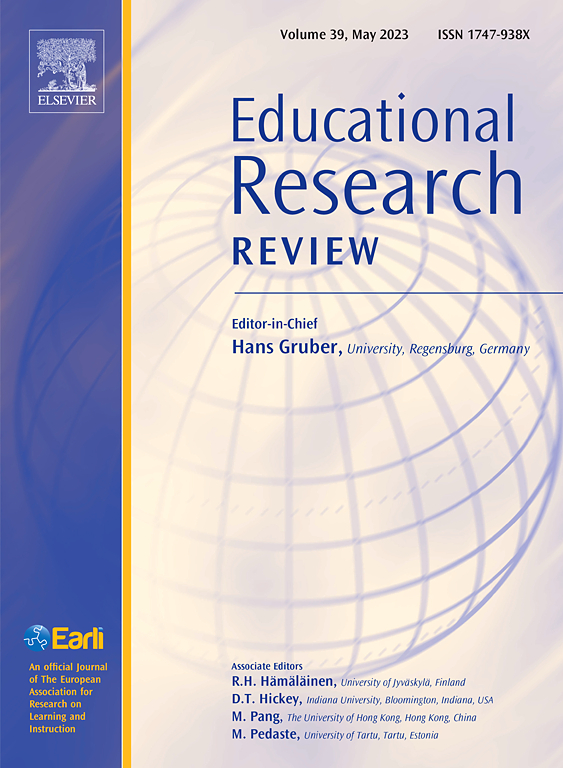社交机器人对儿童语言发展影响的元分析:来自2003年至2023年二十年研究的见解
IF 10.6
1区 教育学
Q1 EDUCATION & EDUCATIONAL RESEARCH
引用次数: 0
摘要
由人工智能驱动的机器人技术正在彻底改变语言学习,特别是对于处于语言发展关键阶段的儿童。然而,随着社交机器人在儿童语言习得中的应用越来越普遍,人们对其在这方面的有效性仍然缺乏全面的了解。为了解决这一差距,本研究对2003年至2023年20年间的27份实证出版物进行了荟萃分析,涉及70个效应量和1544名参与者。结果表明,社交机器人对儿童语言学习有中等到较大的积极影响,尤其是在社交机器人辅助语言学习(SRALL)的情感维度上。社交机器人对语言学习的影响受人口因素(学校水平)、研究设计(社交机器人的角色、语言技能、干预持续时间、语言类型和控制条件)和社交机器人特征的影响。例如,年龄较大的学习者取得了更高的认知结果,而年龄较小的学习者则表现出更大的情感收获。适度延长接触社交机器人的时间可以提高效率,尽管影响取决于机器人的角色和所针对的语言技能。社交机器人在提高说话和混合技能方面特别有用。虽然SRALL在认知维度上表现不明显优于对照组,但在情感维度上表现出显著优势。此外,拟人化机器人比卡通机器人表现出更高的效应大小。这些发现有助于儿童机器人互动的研究和实践,为社交机器人的设计和支持儿童语言学习的教育学的发展提供信息。本文章由计算机程序翻译,如有差异,请以英文原文为准。
Meta–analyzing the impacts of social robots for children's language development: Insights from two decades of research from 2003 to 2023
Robotics technologies powered by artificial intelligence are revolutionizing language learning, particularly for children who are at critical stages of language development. With the increasingly prevalent use of social robots in children's language acquisition, however, a comprehensive understanding of their effectiveness in this regard remains lacking. To address this gap, this study conducted a meta-analysis of 27 empirical publications spanning two decades from 2003 to 2023, involving 70 effect sizes and 1544 participants. The results revealed a moderate to large positive effect of social robots on children's language learning, especially for the affective dimension in social robot-assisted language learning (SRALL). The influence of social robots on language learning was moderated by the demographical factor (school levels), research designs (social robots' roles, language skills, intervention duration, language types, and control conditions), and social robot characteristics. For instance, older learners achieved higher cognitive outcomes, while younger learners showed greater affective gains. Moderately extended exposure to social robots could lead to increased effectiveness, although the impact varied depending on robot roles and the language skills targeted. Social robots were particularly useful for the improvement of speaking and mixed skill sets. While SRALL did not significantly outperform the control conditions in the cognitive dimension, it demonstrated significant advantages in the affective dimension. Additionally, anthropomorphic robots showed a higher effect size than cartoon-like robots. These findings contribute to child-robot interaction research and practice by informing the design of social robots and the development of pedagogy in supporting children's language learning.
求助全文
通过发布文献求助,成功后即可免费获取论文全文。
去求助
来源期刊

Educational Research Review
EDUCATION & EDUCATIONAL RESEARCH-
CiteScore
19.40
自引率
0.90%
发文量
53
审稿时长
57 days
期刊介绍:
Educational Research Review is an international journal catering to researchers and diverse agencies keen on reviewing studies and theoretical papers in education at any level. The journal welcomes high-quality articles that address educational research problems through a review approach, encompassing thematic or methodological reviews and meta-analyses. With an inclusive scope, the journal does not limit itself to any specific age range and invites articles across various settings where learning and education take place, such as schools, corporate training, and both formal and informal educational environments.
 求助内容:
求助内容: 应助结果提醒方式:
应助结果提醒方式:


